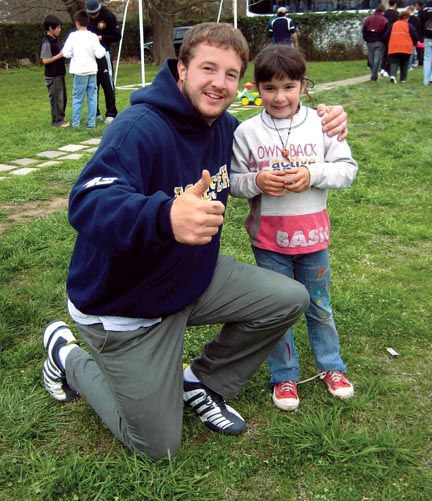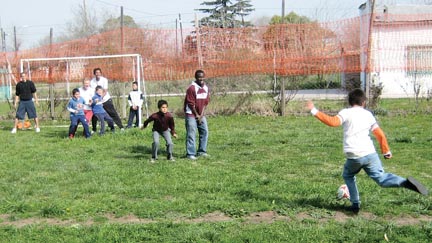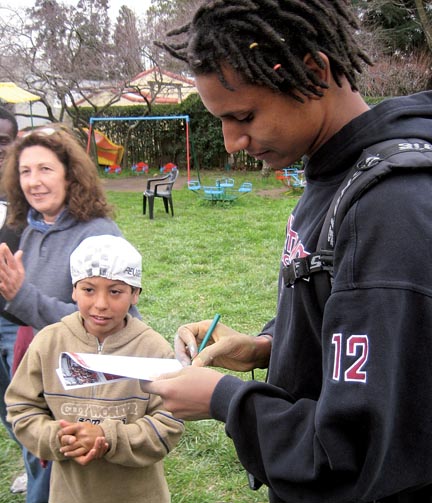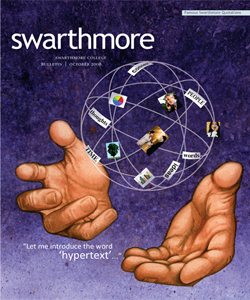Kicking Around South of the Equator

Kyle Leach, director of sports information, accompanied the varsity soccer team to South America in August.
On Aug. 1, the Garnet soccer team, led by Head Coach Eric Wagner, headed south of the equator for a two-week stay in Argentina and Brazil. Director of Sports Information Kyle Leach accompanied the team on their Latin American adventure and, too tall to sleep comfortably on a plane, busied himself at his laptop, relaying the team’s fascinating, exotic, and sometimes exhausting activities back to the College community via detailed, colorful blog posts. An edited excerpt from one of them follows:
A common thread in the Department of Athletics is giving back to the community, mainly through service projects. On a trip to England in 2005, the Garnet soccer team visited a soup kitchen in East London, helping the Quaker Social Action organization. Head Coach Eric Wagner wanted to continue the team’s commitment to this philanthropic ideal in South America, collaborating with Buenos Aires native Francisco Sersale ’02 to find a needy local organization. Through his local football connections, Francisco came across Hogar de Dia (a daycare center).
Located north of Buenos Aires in La Matanza, a desolate section of one-story residences on a flat of land past the lumberyards, steel factories, and a heavily guarded Super-Wal-Mart, Hogar de Dia is funded by a tall, quiet international businessman named Alejandro (a football teammate of Francisco’s).
Upon our arrival, Francisco introduced us to Estella and Ceila, the mother/daughter team who have made it their mission to provide the children of La Matanza with a place where they can seek respite from the tough life of the neighborhood.
As Francisco interpreted, we began to understand the story of these two women, who had run a similar program in the city of Buenos Aires and recently relocated. Children, starting as early as 2 years old and ending on their 13th birthday, spend their afternoons at Hogar de Dia, a low, white concrete structure with an office, classroom, and playroom. A sizeable yard with a pair of soccer goals and an array of playground equipment extends in front of the building. Parent involvement is a vital part of the program. Parents learn how to handle the different situations that typically occur at various stages of child development while volunteering one afternoon a week at the center.

The team interrupted its tour to put in a day of service at a daycare center near Buenos Aires, where—inevitably—a game broke out.
Francisco introduced us to Alberto, a general contractor, who within 15 minutes had 25 Swarthmore guys cleaning, sweeping, and painting. Some clattered on the roof, others tackled renovation of the playground equipment, and a larger group assaulted the exterior walls, careful not to paint over the mural of the baby Jesus. Coach Wagner, Director of Athletics Adam Hertz, and I were sent to the front gate and, using our limited Spanish, received direction from Alberto that a coat of black paint was needed on the 9-by-12–foot iron-and-chain-link gate.
The children arrived around lunchtime, voicing timid greetings as they passed through the gate. Most of them were “alumni” of the program, who had received a special invitation to meet the Americans. The Argentine boys soon produced a ball, and a soccer game broke out. The Swarthmore players could not resist taking breaks from painting to join the scrum.
“All the little kids were good at soccer, and one, Pablo, was awesome,” said sophomore Morgan Langley. “When the game first started, Pablo pulled off some sick moves, even megging Jason Thrope ’09.” (Megging is the tactic of pushing the ball between the defender’s legs.) Morgan, a native of Honolulu, had worked with children as a counselor at Iolani High School summer camps and saw little difference in playing with the Argentine youth. “I was unable to speak the language, but when it came to soccer, I had no trouble getting along with the kids.”
The volunteers and children took a break for lunch, enjoying steak and sausage sandwiches grilled by Carlos, Ceila’s husband. The braver among us tried an Argentine specialty called “black sausage,” which reminded me of scrapple, a Philadelphia favorite. The sausage is pitch-black and very juicy. I had two bites and then ran back for some of the genuine Argentine beef.

The children treated Swarthmore players like Ladule Lako ’09 (right) as celebrities, asking for autographs before they left.
The children became more comfortable with the Swarthmore contingent as the afternoon went along, drawing more of the students away from the painting and into their games. Morgan, in particular, was a favorite, getting invited into a new game the children made up. “It was soccer, but you were only allowed one touch, and if you shot the ball wide, you were banished to goalie. It seemed like an individual game, but I soon realized the kids were passing it back and forth, trying to get me to be the goalie,” he said.
Friendships were forming all over Hogar de Dia. One little girl wandered out to the entrance, where Adam and I were delicately painting the gate as if it someday might hang in the Met. She picked up an idle paintbrush and started slopping black paint on the gate. Mindlessly dripping paint in all directions, the girl began chattering, asking for our names, favorite colors, what languages we could speak. Our Spanish was limited, but she babbled on, happy as could be, just dipping the brush. I asked Francisco to come over and translate, eventually discovering that she wanted to see the bus. The little girl jumped right into the driver’s seat, and her friends soon joined her aboard the bus. Before long, she found the horn and blasted the neighborhood. Thirty seconds later, the bus was filled with giggling children.
At the end of the afternoon, Coach Wagner presented the children with two soccer balls and a handful of team brochures. A rush for markers and pens ensued, and the Swarthmore soccer players were swarmed by autograph seekers.
“I felt famous,” exclaimed Morgan, whose signature was easily the most sought-after. “This was a special experience for me. I’ve done community service before (with the team), but the difference with this one was being able to see the smiles on the kids faces and understand the impact we had.”
To some, sport is exercise. To others, sport is competition. On this day, sport was a unifier, a communicator, and an eye-opener.
To view more of Leach’s postings from Latin America, visit http://kyleleach.wordpress.com.
 Email This Page
Email This Page